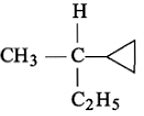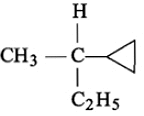The IUPAC name of the following compound is:

1. 4-Bromo-3-cyanophenol
2. 2-Bromo-5-hydroxybenzonitrile
3. 2-cyano-4-hydroxybromobenzene
4. 6-Bromo-3-hydroxybenzonitrile
निम्नलिखित यौगिक का IUPAC नाम है:

1. 4-ब्रोमो-3-सायनोफीनॉल
2. 2-ब्रोमो-5-हाइड्रॉक्सीबेन्जोनाइट्राइल
3. 2-सायनो-4-हाइड्रॉक्सीब्रोमोबेन्जीन
4. 6-ब्रोमो-3-हाइड्रॉक्सीबेन्जोनाइट्राइल


The IUPAC name of
is:
1. 2-(Bromomethyl)-3-oxopentane carboxamide
2. 1-Bromo-2-carbamoylpentan-3-one
3. 5-Bromo-4-carbamoylpentan-3-one
4. 2-(Bromomethyl)-3-oxopentanamide

1. 2-(ब्रोमोमेथिल)-3-ऑक्सोपेन्टेन कार्बोक्सामाइड
2. 1-ब्रोमो-2-कार्बेमॉयलपेन्टेन-3-ओन
3. 5-ब्रोमो-4-कार्बेमॉयलपेन्टेन-3-ओन
4. 2-(ब्रोमोमेथिल)-3-ऑक्सोपेन्टेनामाइड
Most contributing structure in nitroethene is
(1) 


नाइट्रोएथीन में सबसे अधिक योगदान देने वाली संरचना है-
(1) 


The correct order of strengths of the carboxylic acids :-
1. I>II>III
2. II>III>I
3. III>II>I
4. lI>I>IlI
कार्बोक्सिलिक अम्ल की सामर्थ्य का सही क्रम है: -
1. I>II>III
2. II>III>I
3. III>II>I
4. lI>I>IlI
the IUPAC name of the compound shown below is:
(1) 2-bromo-6-chlorocyclohex-1-ene
(2) 6-bromo-6-chlorocyclohexene
(3) 3-bromo-1-chlorocyclohexene
(4) 1-bromo-3-chlorocyclohexene
नीचे दिखाए गए यौगिक का IUPAC नाम है:
1. 2-ब्रोमो-6-क्लोरोसाइक्लोहेक्स-1-ईन
2. 6-ब्रोमो-6-क्लोरोसाइक्लोहेक्सीन
3. 3-ब्रोमो-1-क्लोरोसाइक्लोहेक्सीन
4. 1-ब्रोमो-3-क्लोरोसाइक्लोहेक्सीन
The isomeric cis-2-butene and trans-2-butene can be distinguished on the basis of:
1. their physical nature
2. their reduction products
3. the products they give on ozonolysis
4. the products they give on addition to bromine
2-ब्यूटीन और विपक्ष-2 ब्यूटेन समावयवी समपक्ष को निम्न के आधार पर विभेदित किया जा सकता है:
1. उनकी भौतिक प्रकृति
2. उनके अपचयित उत्पाद
3. वे उत्पाद जो ओजोनीकरण पर देते हैं
4. वे उत्पाद जो ब्रोमीन के योगज में देते हैं
Acid strenght of the conjugate acids of the following are-
(1) I > II > III > IV
(2) III > II > I > IV
(3) IV > III > II > I
(4) None of these
निम्नलिखित के संयुग्मी अम्लों की अम्ल समार्थ्य हैं-
(1) I > II > III > IV
(2) III > II > I > IV
(3) IV > III > II > I
(4) इनमें से कोई नहीं
Consider the acidity of the following carboxylic acids
(i) PhCOOH
(ii) o-NO2C6H4COOH
(iii) p-NO2C6H4COOH
(iv)m-NO2C6H4COOH
1. i>ii>iii>iv
2. ii>iv>iii>i
3. ii>iv>i>iii
4. ii>iii>iv>i
निम्नलिखित कार्बोक्सिलिक अम्ल की अम्लता पर विचार कीजिए
(i) PhCOOH
(ii) o-NO2C6H4COOH
(Iii) p-NO2C6H4COOH
(iv) m-NO2C6H4COOH
1. i>ii>iii>iv
2. ii>iv>iii>i
3. ii>iv>i>iii
4. ii>iii>iv>i
The optically active alkane with lowest molar mass is:
1.
2.
3. 
4.
न्यूनतम मोलर द्रव्यमान के साथ प्रकाशिक रूप से सक्रिय क्षार है:
1.
2.
3. 
4.
Soda extract is prepared by:
1. fusing soda and mixture and, then extracted with water
2. dissolving NaHCO3 and mixture in dil. HCl
3. boiling Na2CO3 and mixture in dil.HCl
4. boiling Na2CO3 and mixture in distilled water
सोडा निष्कर्ष तैयार किया जाता है:
1. सोडा और मिश्रण को संगलित करने पर और, फिर जल के साथ निष्कर्षण द्वारा
2. NaHCO3 और मिश्रण को तनु HCl में घोलने पर
3. Na2CO3 और मिश्रण को तनु HCl में उबालने पर
4. Na2CO3 और मिश्रण को आसुत जल में उबालने पर










